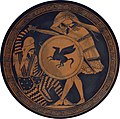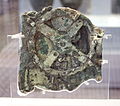Portal:Ancient Greece
The Ancient Greece Portal

Ancient Greece (Greek: Ἑλλάς, romanized: Hellás) was a northeastern Mediterranean civilization, existing from the Greek Dark Ages of the 12th–9th centuries BC to the end of classical antiquity (c. 600 AD), that comprised a loose collection of culturally and linguistically related city-states and other territories. Most of these regions were officially unified only once, for 13 years, under Alexander the Great's empire from 336 to 323 BC. In Western history, the era of classical antiquity was immediately followed by the Early Middle Ages and the Byzantine period.
Three centuries after the Late Bronze Age collapse of Mycenaean Greece, Greek urban poleis began to form in the 8th century BC, ushering in the Archaic period and the colonization of the Mediterranean Basin. This was followed by the age of Classical Greece, from the Greco-Persian Wars to the 5th to 4th centuries BC, and which included the Golden Age of Athens. The conquests of Alexander the Great spread Hellenistic civilization from the western Mediterranean to Central Asia. The Hellenistic period ended with the conquest of the eastern Mediterranean world by the Roman Republic, and the annexation of the Roman province of Macedonia in Roman Greece, and later the province of Achaea during the Roman Empire.
Classical Greek culture, especially philosophy, had a powerful influence on ancient Rome, which carried a version of it throughout the Mediterranean and much of Europe. For this reason, Classical Greece is generally considered the cradle of Western civilization, the seminal culture from which the modern West derives many of its founding archetypes and ideas in politics, philosophy, science, and art. (Full article...)
Selected article -

The military nature of Mycenaean Greece (c. 1600–1100 BC) in the Late Bronze Age is evident by the numerous weapons unearthed, warrior and combat representations in contemporary art, as well as by the preserved Greek Linear B records. The Mycenaeans invested in the development of military infrastructure with military production and logistics being supervised directly from the palatial centres.
Late Bronze Age Greece was divided into a series of warrior kingdoms, the most important being centered in Mycenae, to which the culture of this era owes its name, Tiryns, Pylos and Thebes. From the 15th century BC, Mycenaean power started expanding towards the Aegean, the Anatolian coast and Cyprus. Mycenaean armies shared several common features with other contemporary Late Bronze Age powers: they were initially based on heavy infantry, with spears, large shields and in some occasions armor. In the 13th century BC, Mycenaean units underwent a transformation in tactics and weaponry and became more uniform and flexible and their weapons became smaller and lighter. Some representative types of Mycenaean armor/weapons were the boar's tusk helmet and the "Figure-of-eight" shield. Moreover, most features of the later hoplite panoply of Classical Greece were already known at this time. (Full article...)Selected location -

Did you know...
- ... that after the battle of Plataea, the Greeks swore never to rebuild their sanctuaries, destroyed by the Persians during their invasion of Greece, but to leave them in ruins, as a perpetual reminder of barbarian ferocity?
- ...that Thebes, Greece played an important role in the fabric of Greek myth, being the site of the stories of Cadmus, Oedipus, Dionysus, and others?
- ...that the art of ancient Greece has exercised an enormous influence on the culture of many countries from ancient times until the present, particularly in the areas of sculpture and architecture?
Related portals
Selected biography -
Cleisthenes (/ˈklaɪsθɪniːz/ KLYS-thin-eez; Greek: Κλεισθένης), or Clisthenes (c. 570 – c. 508 BC), was an ancient Athenian lawgiver credited with reforming the constitution of ancient Athens and setting it on a democratic footing in 508 BC. For these accomplishments, historians refer to him as "the father of Athenian democracy". He was a member of the aristocratic Alcmaeonid clan. He was the younger son of Megacles and Agariste making him the maternal grandson of the tyrant Cleisthenes of Sicyon. He was also credited with increasing the power of the Athenian citizens' assembly and for reducing the power of the nobility over Athenian politics.
In 510 BC, Spartan troops helped the Athenians overthrow the tyrant Hippias, son of Peisistratus. Cleomenes I, king of Sparta, put in place a pro-Spartan oligarchy headed by Isagoras. However, Cleisthenes, with the support of the middle class and aided by democrats, took over. Cleomenes intervened in 508 and 506 BC, but could not stop Cleisthenes and his Athenian supporters. Through Cleisthenes' reforms, the people of Athens endowed their city with isonomic institutions—equal rights for all citizens (though only free men were citizens)—and established ostracism as a punishment. (Full article...)General images -
-
The Temple of Concordia, Valle dei Templi, Magna Graecia, in present-day Italy (from Ancient Greece)
-
The ancient Theatre of Epidaurus, 4th century BC (from Ancient Greece)
-
Early Athenian coin, depicting the head of Athena on the obverse and her owl on the reverse – 5th century BC. (from Ancient Greece)
-
Dipylon Vase of the late Geometric period, or the beginning of the Archaic period, c. 750 BC. (from Ancient Greece)
-
Marble bust of Pericles with a Corinthian helmet, Roman copy of a Greek original, Museo Chiaramonti, Vatican Museums; Pericles was a key populist political figure in the development of the radical Athenian democracy. (from Ancient Greece)
-
The gymnasium and palaestra at Olympia, the site of the ancient Olympic games. The archaic period conventionally dates from the first Olympiad. (from Archaic Greece)
-
Gravestone of a woman with her slave child-attendant, c. 100 BC (from Ancient Greece)
-
Homer, author of the earliest surviving Greek literature (from Archaic Greece)
-
Map showing events of the first phases of the Greco-Persian Wars. (from Ancient Greece)
-
Ancient Greek colonies in the archaic period (from Archaic Greece)
-
Inheritance law, part of the Law Code of Gortyn, Crete, fragment of the 11th column. Limestone, 5th century BC (from Ancient Greece)
-
The Parthenon, a temple dedicated to Athena, located on the Acropolis in Athens, is one of the most representative symbols of the culture and sophistication of the ancient Greeks. (from Ancient Greece)
-
Geometric-style box in the shape of a barn. On display in the Ancient Agora Museum in Athens, housed in the Stoa of Attalus. From early geometric cremation burial of a wealthy pregnant woman, 850 BC. (from Greek Dark Ages)
-
Alexander Mosaic, National Archaeological Museum, Naples. (from Ancient Greece)
-
The remains of the Temple of Apollo at Corinth, the first Greek temple to be built in stone. (from Archaic Greece)
-
The Vix Krater, an imported Greek wine-mixing bronze vessel found in the Hallstatt/La Tène grave of the "Lady of Vix", Burgundy, France, c. 500 BC (from Archaic Greece)
-
Map showing the major regions of mainland ancient Greece and adjacent "barbarian" lands. (from Ancient Greece)
-
Map of the Late Bronze Age collapse (c. 1200 BC) in the Eastern Mediterranean (from Greek Dark Ages)
-
Delian League ("Athenian Empire"), immediately before the Peloponnesian War in 431 BC. (from Ancient Greece)
-
The lawgiver Solon reformed the Athenian constitution, which led to significant developments in Greece at the time (from Archaic Greece)
-
An Ancient Greek pair of terracotta boots. Early geometric period cremation burial of a woman, 900 BC. Ancient Agora Museum in Athens. (from Greek Dark Ages)
-
The carved busts of four ancient Greek philosophers, on display in the British Museum. From left to right: Socrates, Antisthenes, Chrysippus, and Epicurus. (from Ancient Greece)
-
A scene from the Iliad: Hypnos and Thanatos carrying the body of Sarpedon from the battlefield of Troy; detail from an Attic white-ground lekythos, c. 440 BC (from Ancient Greece)
-
Finds from an early geometric Cremation Burial of a pregnant wealthy woman, from the N.W. of the Areopagus, about 850 BC, Ancient Agora Museum (Athens); exhibit 14–16: broad gold finger rings; exhibit 17–19: gold finger rings; 20: pair of gold earrings with trapezoid endings (from Greek Dark Ages)
-
Greek hoplite and Persian warrior depicted fighting, on an ancient kylix, 5th century BC. (from Ancient Greece)
-
The major Hellenistic realms included the Diadochi kingdoms:Kingdom of Ptolemy I SoterKingdom of CassanderKingdom of LysimachusKingdom of Seleucus I NicatorAlso shown on the map:Carthage (non-Greek)Rome (non-Greek)
The orange areas were often in dispute after 281 BC. The Attalid dynasty occupied some of this area. Not shown: Indo-Greek Kingdom. (from Ancient Greece) -
The Antikythera mechanism was an analog computer from 150 to 100 BC designed to calculate the positions of astronomical objects. (from Ancient Greece)
-
Ruins of the Temple of Apollo within the polis of Ancient Corinth, built c. 540 BC, with the Acrocorinth (the city's acropolis) seen in the background (from Archaic Greece)
-
The Temple of Concordia, Valle dei Templi, Magna Graecia, in present-day Italy (from Archaic Greece)
-
The Victorious Youth (c. 310 BC) is a rare, water-preserved bronze sculpture from ancient Greece. (from Ancient Greece)
Selected picture

Photo credit: Jastrow
The Parthenon Frieze is the low relief, pentelic marble sculpture created to adorn the upper part of the Parthenon’s naos. It was sculpted between ca. 443 and 438 BC most likely under the direction of Phidias. 420 ft of the original frieze survives, some 80%, the rest is known only from the drawings made by flemish artist Jacques Carrey in 1674 if at all.
Topics
Life: Agriculture · Art · Cuisine · Democracy · Economy · Language · Law · Medicine · Paideia · Pederasty · Pottery · Prostitution · Slavery · Technology · Olympic Games
Philosophers: Pythagoras · Heraclitus · Parmenides · Protagoras · Empedocles · Democritus · Socrates · Plato · Aristotle · Zeno · Epicurus
Authors: Homer · Hesiod · Pindar · Sappho · Aeschylus · Sophocles · Euripides · Aristophanes · Menander · Herodotus · Thucydides · Xenophon · Plutarch · Lucian · Polybius · Aesop
Buildings: Parthenon · Temple of Artemis · Acropolis · Ancient Agora · Arch of Hadrian · Temple of Zeus at Olympia · Colossus of Rhodes · Temple of Hephaestus · Samothrace temple complex
Chronology: Aegean civilization · Minoan Civilization · Mycenaean civilization · Greek dark ages · Classical Greece · Hellenistic Greece · Roman Greece
People of Note: Alexander The Great · Lycurgus · Pericles · Alcibiades · Demosthenes · Themistocles · Archimedes · Hippocrates
Art and Sculpture: Kouroi · Korai · Kritios Boy · Doryphoros · Statue of Zeus · Discobolos · Aphrodite of Knidos · Laocoön · Phidias · Euphronios · Polykleitos · Myron · Parthenon Frieze · Praxiteles
Subcategories
Things to do
 |
Here are some tasks awaiting attention:
|
Associated Wikimedia
The following Wikimedia Foundation sister projects provide more on this subject:
-
Commons
Free media repository -
Wikibooks
Free textbooks and manuals -
Wikidata
Free knowledge base -
Wikinews
Free-content news -
Wikiquote
Collection of quotations -
Wikisource
Free-content library -
Wikiversity
Free learning tools -
Wiktionary
Dictionary and thesaurus






















































